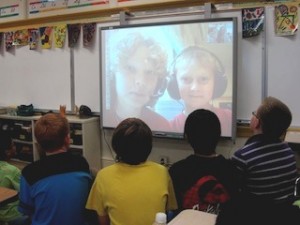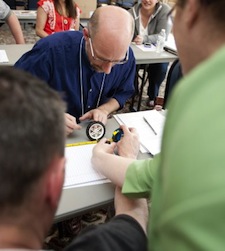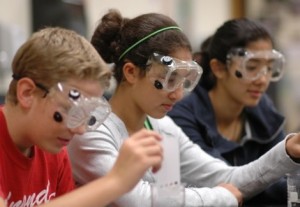Are You STEM-Ready This Year?
A MiddleWeb Blog
Are you ready for STEM? Is your new multi-million dollar facility completely furnished? Is your staff of thoroughly STEM-prepared teachers ready to go?
Have you found a place to put the abundance of STEM resources and materials that were delivered to your school? Have you found ways for teachers to have extra meeting time during the day? Then you’re STEM-ready!
Oh — that’s not exactly your situation?
You’re not where you want to be yet? Welcome to the myriad of schools that are just getting this STEM thing off the ground. Whatever your situation, you can begin to ramp up for great STEM learning by following some advice gathered from educators who’ve been teaching STEM classes successfully for several years.
First things first: Prepare yourself for noisy, exuberant classrooms where multiple right answers abound and failure is regarded as a positive step toward discovery and a successful solution. Get ready for kids to work closely together, using hands-on methods to solve real-world problems. Be willing to step back and give students enough room to kick off their journey toward becoming creative, innovative, critical thinkers.
Check List for Launch
So how do you prepare for the STEM adventure? You might begin by taking a look at this checklist of 5 questions your school needs to consider.
1. Does everyone know WHY the school is implementing STEM and what STEM is designed to accomplish? Some reasons often cited include these:
• We want to prepare our students for successful careers in a 21st century workforce. For kindergarteners this may seem a bit premature, but the kinds of thinking skills and problems solving required for success in the workplace start here.
• We want our students to be better prepared in math and science. And what about art, math, history, language arts, and other subjects? Is there a connection between STEM productivity and these subjects? You bet! Developing the STEM skills listed in the next bullet can happen in any subject. And the idea of building learning connections among subjects is a real eye-opener for many students.

– Problem-solving
– Innovative thinking
– Communications
– Productive teamwork
– Generating multiple ideas
– Decision-making
• We want our students to learn to work productively in teams. This is difficult in a culture designed for individual work and achievement and deserves plenty of attention.
2. What type of STEM program will your school implement initially and what do you want this program to become? In other words, what will it look like now and what do you want it to look like when it’s all grown up? This post identifies the basic ingredients of a real STEM program. You also need to consider where your initial STEM program will fit within the school organization. (Remember that this can be the first step to a broader program.) Will it be . . .
• A STEM Program within the school. This might be:
– STEM taught in one classroom only
– STEM taught in one subject only, such as science or math
– STEM taught in both science and in math, but in isolation
– Science and math STEM lessons closely integrated and teachers planning together.
– Arts or another subject added to the STEM program
• A STEM specialty school
STEM integrated throughout school. The entire school’s focus is on STEM and every student participates in a curriculum of science, technology, engineering, and mathematics. Other subjects correlate and teach basic STEM process skills.
• Electives
STEM will be taught as an elective during the school day
• After school programs
A number of afterschool STEM programs are in operation. These are often built around the belief that STEM learning during the school day is necessary but not sufficient for life-long STEM literacy. Afterschool programs make valuable contributions to the strength and diversity of STEM learning and should be a component of regular school STEM programs.
3. How will you prepare and support teachers? What do teachers know/need to know, and how will they learn it? So you have one dynamic, willing teacher who is willing to teach STEM. That’s great – for the kids he/she teaches. What you really need is a school full of prepared and dynamic teachers to make a difference for all kids. So, where will you start, and what do you want this to look like when your teacher support is in place? The PBS Teachers STEM Education Resource offers opportunities for your school staff to explore new ideas related to STEM learning. This STEM Smart Brief offers recommendations for preparing and supporting your STEM educators. Here are some excerpts:

• Be sure the training is aligned with your district curricula. Teachers need to be learning what they actually will be teaching.
• Provide on-site professional support that allows for regular interaction and collaboration with colleagues, such as professional learning communities. Teachers need to work together to try out new strategies in their classrooms, report back on their experiences, discuss, reflect, and learn from them.
• Provide multiple and sustained opportunities for continued learning on an ongoing basis. This is critical for implementing a new initiative.
4. What will your school do about STEM curriculum? Be ready to kick-off the STEM program at the beginning of the school year, if possible. Remember – this is where you will start, and will help your STEM curriculum grow into what you want it to be.
• Have at least one STEM lesson developed and ready to go, with others in the planning stage. For tips on how to design STEM lessons, see this previous blog post: You can find good STEM lessons online, but be sure they follow the guidelines for real STEM in the next bullet. Check out the NEA 10 Best STEM Resources site for ideas.
• Examine the lesson and ask, “Is it STEM?” A lot of lessons are trying to fly under the name of STEM. Does the lesson you are using pass these tests:
– Does it engage students in the engineering design process?
– Do students address a real-world problem?
– Do they work in teams to solve this problem?
– Are there multiple possible solutions?
– Do students get to explore and come up with ideas on their own, without being spoon-fed?
If so, then you can feel pretty sure you’re dealing with the real thing. These tips on how to plan STEM curriculum might be useful as well.
5. What resources are available? You will definitely want to grow your STEM resources as the year goes on.

• Line up human resources and support. Involve business leaders, parents, university educators, policy-makers, etc.
• Gather materials and supplies. You may need to start with inexpensive materials – paper and craft sticks. These will always be okay for some types of challenges. However, as funding permits, plan on getting “real” tools of the engineering trade for students to use, especially in the upper grades.
To sum it up, your school can be STEM-ready so long as you have a starting point and a long term goal. Just remember that this initiative will keep growing with some visionary leadership. A knowledgeable and supportive school principal is the most important driver behind a STEM initiative.
Oh, yes, and while you’re at it, convince a group of gung-ho parents to form a STEM booster club. Build a group of school + community STEM advocates and innovators who are ready to go out and tell the powers-that-be that we want our kids ready for a STEM world!





































Hi Anne! Good News! My school is full of local, national and even State Educational leaders that want to implement STEM support. We are having a meeting next month and I would like to give them a platform of needs and best uses of their time, talent and money. Can you please assist? I follow your posts weekly.
Fondly,
Linda Schwerer
Charter Schools Associates
Math Coach/STEM Coordinator
Wow, Linda – that sounds like quite a challenge! A happy challenge at that. Let me see if I understand – you have various education leaders in your school (parents of kids perhaps?). These folks want to support a STEM program in the school. You want to know what specific sorts of support they can provide. Correct?
I’d like to know things like whether your program is already in progress, just getting ready to start, or in the planning stage. What type of STEM do you want to implement – a schoolwide model, STEM in science and math? a pilot STEM course in one or two classrooms?
If you’d like to talk via telephone then please email me ajolly@bellsouth.net. Then I can do a blog post on the ideas we come up with so everyone can chime in. Or, we can continue the conversation here.